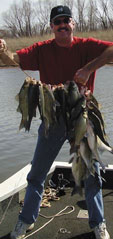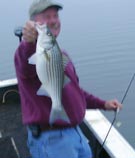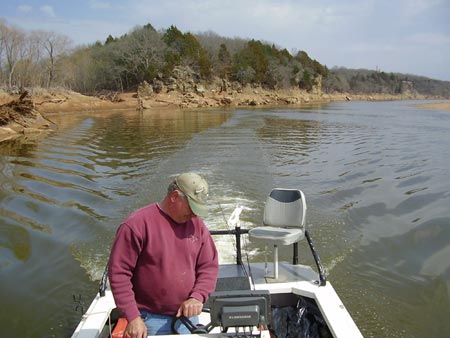
-
A Jetboat,
A Shallow River,
A Lot of Sandies
Tony Hughes is one of the most avid and knowledgable "lineside" fishermen you will ever meet. So when Tony invited me on an early March fishing trip up the shallow, sandy Cimarron that feeds into Keystone Lake, I jumped at the opportunity. He'd told me tales about the tremendous sandbass fishing that could be found at times up the feeder stream where ordinary prop-driven boats were unable to reach. My boat would never make it and I really wanted to experience something new.
Tony has a jet-boat, an aluminum flat-bottom-hull fishing boat that has definitely seen it's share of shallow sand and rocks in countless quests to catch big stripers. Built for shallow streams, you buy one of these boats with the intentions of doing some serious and often rough river fishing. And that he does.
I met up with Tony at the lake well before dawn and we motored off the ramp at Appalachia Bay. Just before launching, we'd noticed the baitfish that could be heard and barely seen flipping across the calm surface of the cove, so we decided to throw a few artificials at the mouth of the cove before heading up the lake and on into the Cimarron.
Tony quickly picked up a three pound striper off the long sandy point that slopes across the bay's mouth. 
I had a light hit or two, but couldn't connect.
A short time before dawn Tony started the inboard engine and we headed up the lake, stopping only once on the upper arm to net some small shad before entering the shallow, and in some places only inches deep Cimarron.
We skimmed through many areas where it looked as if the boat would be left high-and-dry. But Tony always nailed the throttle and scooted on through, leaving a long trail of red mud behind the boat.
A half mile up the sandy red-stained stream, we stopped and threw dark-colored 3-inch Wildeyes. We caught a few sandies along the sandy banks, but the fish weren't hitting at the spot like Tony said they had been.
Moving on up the river, we entered cleaner water.
Tony headed on, looking for one of the many deeper holes along the base of some of the steeper hills. I had to wonder, "just exactly how far the walk would be if the boat failed to restart". Well into the river now, Tony stopped at the head of a long fourteen to fifteen foot deep stretch of water and anchored just off a sand bar. We found the sandies.
These fish didn't want Wildeyes. They wanted shad and they wanted the shad to be bouncing slowly along the bottom. Most fish would strike the bait when it started rolling off the shallow sand bar into deeper water.
The hard-hitting spring sandies were not relating to the rocky banks as much as they were to the calm water eddys just below the flowing current.
We ended up catching a bunch of scrappy, good-sized sand bass but found no striper. Tony said the striper probably wouldn't be up the river unless a lot more shad schooled their way up the stream.
We also didn't see the six-legged cow that Tony claimed roamed the bank along that area. But we did see a group of wild turkey and a number of fishermen who seemed bewildered to see a boat flying up their personal piece of river, sliding sideways around sand bars, tree snags and accelerating through the shallowest areas.
It was great fun, good company and an experience not to be forgotten.
On the way back to the ramp, Tony's cruising boat hit a really shallow area and the sand sucked the boat to a sudden and near halt. I was tossed to the front of the boat, but landed on all fours without any body damage.
Tony grinned as the boat made it across the obstacle.
"I told you to be ready," he laughed.
Next time, I'll be ready. I've got an old motorcycle helmet somewhere.

Williams Fishing Home Page